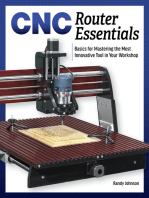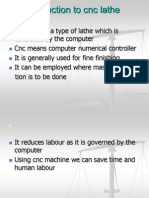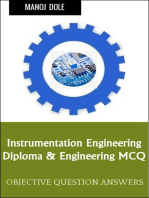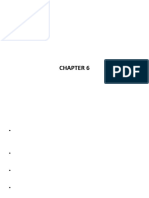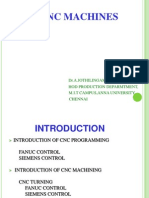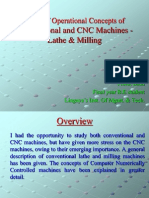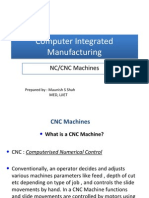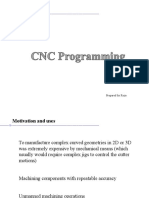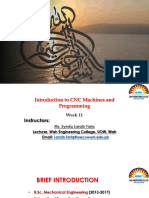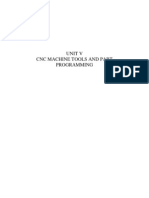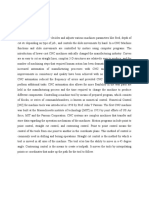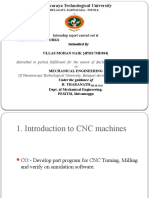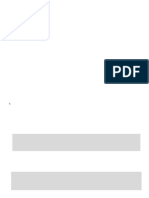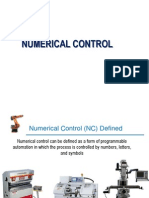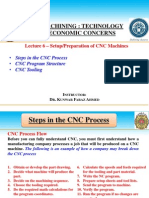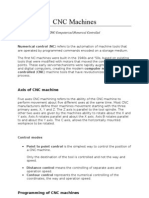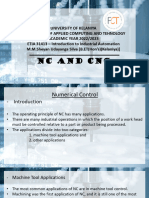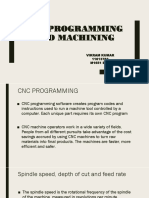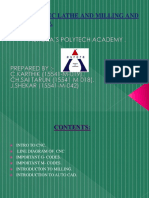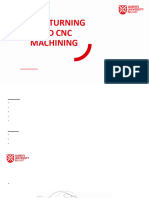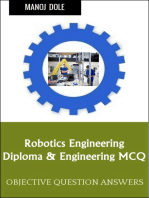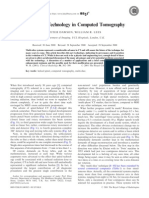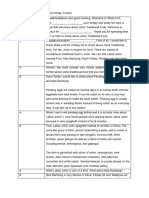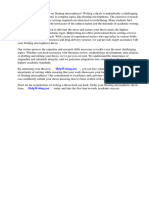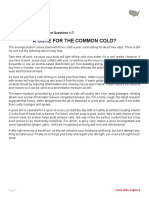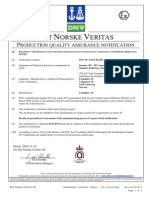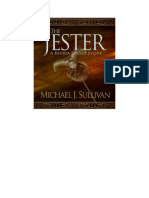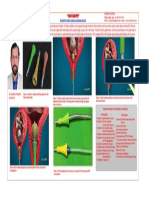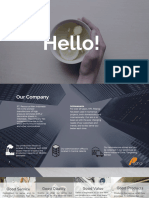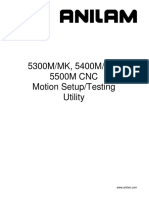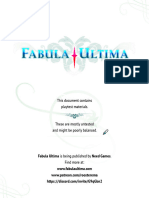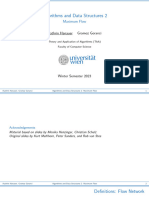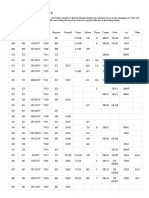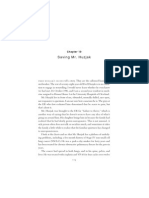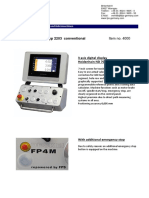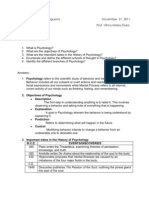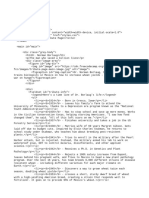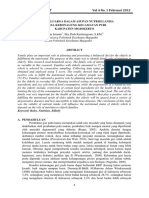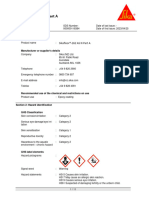Introduction To CNC Machining: Department of Materials and Metallurgical Engineering IIT Kanpur
Introduction To CNC Machining: Department of Materials and Metallurgical Engineering IIT Kanpur
Uploaded by
vikasCopyright:
Available Formats
Introduction To CNC Machining: Department of Materials and Metallurgical Engineering IIT Kanpur
Introduction To CNC Machining: Department of Materials and Metallurgical Engineering IIT Kanpur
Uploaded by
vikasOriginal Title
Copyright
Available Formats
Share this document
Did you find this document useful?
Is this content inappropriate?
Copyright:
Available Formats
Introduction To CNC Machining: Department of Materials and Metallurgical Engineering IIT Kanpur
Introduction To CNC Machining: Department of Materials and Metallurgical Engineering IIT Kanpur
Uploaded by
vikasCopyright:
Available Formats
Introduction to
CNC Machining
Krishanu Biswas
Department of Materials and Metallurgical Engineering
IIT Kanpur
K.Biswas (Spring 2010)
CNC Machines
What is a CNC Machine?
CNC : Computer and Numeric Control
Conventionally, an operator decides and adjusts
various machines parameters like feed , depth of
cut etc depending on type of job , and controls
the slide movements by hand. In a CNC
Machine functions and slide movements are
controlled by motors using computer programs.
K.Biswas (Spring 2010)
For a CNC machine control unit (MCU) decides cutting
speed, feed, depth of cut, tool selection , coolant on off
and tool paths. The MCU issues commands in form of
numeric data to motors that position slides and tool
accordingly.
K.Biswas (Spring 2010)
Overview
A numerical control, or NC, system controls many machine
functions and movements which were traditionally performed
by skilled machinists.
Numerical control developed out of the need to meet the
requirements of high production rates, uniformity and
consistent part quality.
Programmed instructions are converted into output signals
which in turn control machine operations such as spindle
speeds, tool selection, tool movement, and cutting fluid flow.
Figure 1: Basic components of CNC
K.Biswas (Spring 2010)
Overview
By integrating a computer processor, computer
numerical control, or CNC as it is now known,
allows part machining programs to be edited and
stored in the computer memory as well as
permitting diagnostics and quality control functions
during the actual machining.
All CNC machining begins with a part program,
which is a sequential instructions or coded
commands that direct the specific machine
functions.
The part program may be manually generated or,
more commonly, generated by computer aided part
K.Biswas (Spring 2010)
Basic CNC Principles
All computer controlled machines are able to accurately and
repeatedly control motion in various directions. Each of these
directions of motion is called an axis. Depending on the machine type
there are commonly two to five axes.
Additionally, a CNC axis may be either a linear axis in which
movement is in a straight line, or a rotary axis with motion following a
circular path.
Figure 2:
K.Biswas (Spring 2010)
Motion control - the heart of
CNC
The most basic function of any CNC machine is automatic,
precise, and consistent motion control.
Rather than applying completely mechanical devices to
cause motion as is required on most conventional machine
tools, CNC machines allow motion control in a
revolutionary manner.
All forms of CNC equipment have two or more directions
of motion, called axes. These axes can be precisely and
automatically positioned along their lengths of travel.
The two most common axis types are linear (driven along
a straight path) and rotary (driven along a circular path).
K.Biswas (Spring 2010)
Basic CNC Principles
Coordinates System
Absolute Coordinate System
Incremental Coordinate System
K.Biswas (Spring 2010)
Basic CNC Principles
Each axis consists of a mechanical component, such as a slide that
moves, a servo drive motor that powers the mechanical movement, and
a ball screw to transfer the power from the servo drive motor to the
mechanical component.
These components, along with the computer controls that govern them,
are referred to as an axis drive system.
Figure 3:
K.Biswas (Spring 2010)
Basic CNC Principles
Using a vertical mill
machining center as an
example, there are
typically three linear axes
of motion. Each is given
an alphabetic designation
or address. The machine
table motion side to side
is called the X axis.
Table movement in and
out is the Y axis, while
head movement up and
down the column is the
Z axis.
Figure 4
K.Biswas (Spring 2010)
Basic CNC Principles
If a rotary table is added to the machine table, then
the fourth axis is designated the b axis.
Figure 5
K.Biswas (Spring 2010)
Work Positioning
The method of accurate work positioning in relation to the cutting tool is
called the rectangular coordinate system. On the vertical mill, the
horizontal base line is designated the X axis, while the vertical base line
is designated the Y axis. The Z axis is at a right angle, perpendicular to
both the X and Y axes.
Increments for all base lines are specified in linear measurements, for
most machines the smallest increment is one ten-thousandth of an inch
(.0001). If the machine is graduated in metric the smallest increment is
usually one thousandth of a millimeter (.001mm).
The rectangular coordinate system allows the mathematical plotting of
points in space. These points or locations are called coordinates. The
coordinates in turn relate to the tool center and dictate the tool path
through the work.
K.Biswas (Spring 2010)
Basic CNC Principles
Figure 6:
K.Biswas (Spring 2010)
CNC MachinesAdvantages/Disadvantages
Advantages:
High Repeatability and Precision e.g. Aircraft parts
Volume of production is very high
Complex contours/surfaces need to be machined. E.g. Turbines
Flexibility in job change, automatic tool settings, less scrap
More safe, higher productivity, better quality
Less paper work, faster prototype production, reduction in lead times
Disadvantages:
Costly setup, skilled operators
Computers, programming knowledge required
Maintenance is difficult
K.Biswas (Spring 2010)
Types of Machine
Lathes for metal and plastics
Used to produce 3D product shapes and
moulds for plastic products.
Milling machine for mould making and
surface milling.
Used to produce dies for
die cutting printed products.
K.Biswas (Spring 2010)
CNC Lathe
Automated version of a manual lathe.
Programmed to change tools
automatically.
Used for turning and boring wood, metal
and plastic.
K.Biswas (Spring 2010)
CNC Milling Machine
Has 3 to 5 axes.
Used for wood, metal and plastic.
Used to make 3D prototypes, moulds,
cutting dies, printing plates and signs.
K.Biswas (Spring 2010)
How CNC Works
Controlled by G and M codes.
These are number values and coordinates.
Each number or code is assigned to a
particular operation.
Typed in manually to CAD by machine
operators.
G&M codes are automatically generated
by the computer software.
K.Biswas (Spring 2010)
Features of CNC Machinery
The tool or material moves.
Tools can operate in 1-5 axes.
Larger machines have a machine control
unit (MCU) which manages operations.
Movement is controlled by a motors
(actuators).
Feedback is provided by sensors
(transducers)
Tool magazines are used to change tools
K.Biswas (Spring 2010)
Tools
Most are made from
high speed steel (HSS),
tungsten carbide or ceramics.
Tools are designed to direct waste away
from the material.
Some tools need coolant such as oil to
protect the tool and work.
K.Biswas (Spring 2010)
Tool Paths, Cutting
and Plotting Motions
Tool paths describes the route the cutting tool takes.
Motion can be described as point to point, straight
cutting or contouring.
Speeds are the rate at which the tool operates e.g. rpm.
Feeds are the rate at which the cutting tool and work
piece move in relation to each other.
Feeds and speeds are determined by cutting depth,
material and quality of finish needed. e.g. harder
materials need slower feeds and speeds.
Rouging cuts remove larger amounts of material than
finishing cuts.
Rapid traversing allows the tool or work piece to move
rapidly when no machining is taking place.
K.Biswas (Spring 2010)
Point to Point and Tool Paths
Figure 7:
Figure 8:
K.Biswas (Spring 2010)
CNC Programming Basics
CNC instructions are called part program commands.
When running, a part program is interpreted one
command line at a time until all lines are completed.
Commands, which are also referred to as blocks, are
made up of words which each begin with a letter address
and end with a numerical value.
K.Biswas (Spring 2010)
CNC Programming Basics
Each letter address relates to a specific machine
function. G and M letter addresses are two of the
most common. A G letter specifies certain machine
preparations such as inch or metric modes, or absolutes
versus incremental modes.
A M letter specifies miscellaneous machine functions
and work like on/off switches for coolant flow, tool
changing, or spindle rotation. Other letter addresses are
used to direct a wide variety of other machine
commands.
K.Biswas (Spring 2010)
CNC programming
Important things to know:
Coordinate System
Units, incremental or absolute positioning
Coordinates: X,Y,Z, RX,RY,RZ
Feed rate and spindle speed
Coolant Control: On/Off, Flood, Mist
Tool Control: Tool and tool parameters
K.Biswas (Spring 2010)
CNC programming
Programming consists of a series of instructions in form of letter
codes
Preparatory Codes:
G codes- Initial machining setup and establishing operating
conditions
N codes- specify program line number to executed by the MCU
Axis Codes: X,Y,Z - Used to specify motion of the slide along X, Y,
Z direction
Feed and Speed Codes: F and S- Specify feed and spindle speed
Tool codes: T specify tool number
K.Biswas (Spring 2010)
Programming Key Letters
O - Program number (Used for program identification)
N - Sequence number (Used for line identification)
G - Preparatory function
X - X axis designation
Y - Y axis designation
Z - Z axis designation
R - Radius designation
F Feed rate designation
S - Spindle speed designation
H - Tool length offset designation
D - Tool radius offset designation
T - Tool Designation
M - Miscellaneous function
K.Biswas (Spring 2010)
Explanation of commonly
used G codes
G00 Preparatory code to control final position of the
tool and not concerned with the path that is followed in
arriving at the final destination.
G01 Tool is required to move in a straight line
connecting current position and final position. Used for
tool movement without any machining- point to point
control. (linear interpolation)
G02 Tool path followed is along an arc specified by I, J
and K codes.( circular interpolation)
K.Biswas (Spring 2010)
Table of Important G codes
G00 Rapid Transverse
G01 Linear Interpolation
G02 Circular Interpolation, CW
G03 Circular Interpolation, CCW
G17 XY Plane,G18 XZ Plane,G19 YZ Plane
G20/G70 Inch units
G21/G71 Metric Units
G40 Cutter compensation cancel
G41 Cutter compensation left
G42 Cutter compensation right
G43 Tool length compensation (plus)
G43 Tool length compensation (plus)
G44 Tool length compensation (minus)
G49 Tool length compensation cancel
G80 Cancel canned cycles
G81 Drilling cycle
G82 Counter boring cycle
G83 Deep hole drilling cycle
G90 Absolute positioning
G91 Incremental positioning
K.Biswas (Spring 2010)
Table of Important M codes
M00 Program stop
M01 Optional program stop
M02 Program end
M03 Spindle on clockwise
M04 Spindle on counterclockwise
M05 Spindle stop
M06 Tool change
M08 Coolant on
M09 Coolant off
M10 Clamps on
M11 Clamps off
M30 Program stop, reset to start
K.Biswas (Spring 2010)
Program Command Parameters
Optimum machine programming requires consideration of certain machine
operating parameters including:
Positioning control
Compensations
Special machine features
Positioning control is the ability to program tool and machine slide movement
simultaneously along two or more axes. Positioning may be for point-to-point
movement or for contouring movement along a continuous path. Contouring
requires tool movement along multiple axes simultaneously. This movement is
referred to as Interpolation which is the process of calculating intermediate
values between specific points along a programmed path and outputting those
values as a precise motion. Interpolation may be linear having just a start and
end point along a straight line, or circular which requires an end point, a center
and a direction around the arc.
K.Biswas (Spring 2010)
Rules for programming
Block Format
N135 G01 X1.0 Y1.0 Z0.125 F5
Sample Block
Restrictions on CNC blocks
Each may contain only one tool move
Each may contain any number of non-tool move G-codes
Each may contain only one feed rate
Each may contain only one specified tool or spindle speed
The block numbers should be sequential
Both the program start flag and the program number must be
independent of all other commands (on separate lines)
The data within a block should follow the sequence shown
in the above sample block
K.Biswas (Spring 2010)
CAD/CAM
Two computer-based systems which impact the use of CNC technology are
computer aided design and computer aided manufacturing.
A computer aided design, or CAD, system uses computers to graphically create
product designs and models. These designs can be reviewed, revised, and
refined for optimum end use and application. Once finalized, the CAD design is
then exported to a computer aided manufacturing, or CAM, system.
CAM systems assist in all phases of manufacturing a product, including process
planning, production planning, machining, scheduling, management and quality
control.
K.Biswas (Spring 2010)
APT Programming Example
25
Cylindrical Part
Raw Material
Finished Part
20
22.5
17.5
70
K.Biswas (Spring 2010)
APT Programming Example (Cylindrical
O0013
N0005
N0010
N0020
N0030
N0040
N0050
N0060
N0070
N0080
N0090
N0100
N0110
N0120
N0130
Part)
G53
T0303
G57 G00 X26.00 Z0.0 S500 M04
G01 X-0.20 F100
G00 Z2.0
X50.0 Z50.0
T0404
G57 G00 X22.50 Z2.0 S500
G01 Z-30.0 F100
G00 X23.0 Z2.0 S500
G84 X17.5 Z-20.0 D0=200 D2=200 D3=650
G00 Z2.0
X50.0 Z50.0
M30
Thank You
You might also like
- Brancalonia - Macaronicon PDFDocument164 pagesBrancalonia - Macaronicon PDFJessy Debarbieux100% (8)
- Machinery's Handbook Guide: A Guide to Tables, Formulas, & More in the 31st EditionFrom EverandMachinery's Handbook Guide: A Guide to Tables, Formulas, & More in the 31st EditionRating: 5 out of 5 stars5/5 (2)
- CNC Router Essentials: The Basics for Mastering the Most Innovative Tool in Your WorkshopFrom EverandCNC Router Essentials: The Basics for Mastering the Most Innovative Tool in Your WorkshopRating: 5 out of 5 stars5/5 (3)
- The CNC Handbook: Digital Manufacturing and Automation from CNC to Industry 4.0From EverandThe CNC Handbook: Digital Manufacturing and Automation from CNC to Industry 4.0Rating: 5 out of 5 stars5/5 (1)
- Introduction To CNC LatheDocument18 pagesIntroduction To CNC Lathebest4reverNo ratings yet
- An Introduction To CNC MachinesDocument20 pagesAn Introduction To CNC Machinesbulon09100% (1)
- Report CNC MillingDocument16 pagesReport CNC Millingharislukman100% (5)
- CNC PresentationDocument37 pagesCNC PresentationMarvin BelenNo ratings yet
- CNC Machine FundaDocument95 pagesCNC Machine FundaHarpreet SinghNo ratings yet
- Ch_6 Computer Numerical Control(1)Document59 pagesCh_6 Computer Numerical Control(1)Do Thi My LeNo ratings yet
- CNC MillDocument100 pagesCNC MillKhai HuynhNo ratings yet
- Welcome: Industrial Trainig Institute. Palana. Centre of ExcellenceDocument100 pagesWelcome: Industrial Trainig Institute. Palana. Centre of ExcellenceAthar MahmoodNo ratings yet
- Cncpresentation PDFDocument37 pagesCncpresentation PDFCorey YoungNo ratings yet
- CNCDocument76 pagesCNCAlexandru Precup100% (1)
- 9.pmat M-01Document94 pages9.pmat M-01mailtome126100% (1)
- Introduction To CNC MachinesDocument15 pagesIntroduction To CNC Machinespranjal priyeNo ratings yet
- CNC Basic & Prog.Document89 pagesCNC Basic & Prog.Christine BrownNo ratings yet
- Computer Aided Manufacturing Part 1Document76 pagesComputer Aided Manufacturing Part 1lelisadiriba849No ratings yet
- CNC CimDocument16 pagesCNC CimAbdulhmeed MutalatNo ratings yet
- Study of Operational Concepts Of: Conventional and CNC Machines - Lathe & MillingDocument38 pagesStudy of Operational Concepts Of: Conventional and CNC Machines - Lathe & MillingUpender DhullNo ratings yet
- CNC1Document91 pagesCNC1Revana KadurNo ratings yet
- CNC Part ProgrammingDocument40 pagesCNC Part ProgrammingmsshahenterNo ratings yet
- CNC Part ProgrammingDocument53 pagesCNC Part ProgrammingmsshahenterNo ratings yet
- CNC Machines-An Introduction: Department of Mechanical Engineering Indian Institute of Technology PatnaDocument49 pagesCNC Machines-An Introduction: Department of Mechanical Engineering Indian Institute of Technology PatnaShiva SinghNo ratings yet
- Experiment No 6Document11 pagesExperiment No 6harisraja47985No ratings yet
- CNC1Document91 pagesCNC1Liv CBNo ratings yet
- L-23 (SM) (Ia&c) ( (Ee) Nptel)Document23 pagesL-23 (SM) (Ia&c) ( (Ee) Nptel)Jayesh BaldotaNo ratings yet
- Introduction To Computer Numerically Controlled (CNC) MachinesDocument23 pagesIntroduction To Computer Numerically Controlled (CNC) MachinesRafi ShaikNo ratings yet
- Introduction To CNC MachineDocument5 pagesIntroduction To CNC MachineRik ChattopadhyayNo ratings yet
- CNC Programming Intro & Code PDFDocument127 pagesCNC Programming Intro & Code PDFAswath SridharNo ratings yet
- Lecture-5 - CNC Programming, G and M CodesDocument93 pagesLecture-5 - CNC Programming, G and M Codesnomibashir0115No ratings yet
- CNC Machines-1Document79 pagesCNC Machines-1LAVNIMESH AGNIHOTRINo ratings yet
- Unit 5 Me1203Document25 pagesUnit 5 Me1203Muthuvel M100% (1)
- EML2322L-CNC Machining PDFDocument17 pagesEML2322L-CNC Machining PDFIvan JarebNo ratings yet
- MCU EtcDocument22 pagesMCU EtcAjay Kumar BathulaNo ratings yet
- AbhayDocument23 pagesAbhayAshish KumarNo ratings yet
- CNC MachinesDocument35 pagesCNC Machinesfitriarp100% (1)
- ULLASDocument36 pagesULLASKiranNo ratings yet
- Computer Numerical Control CNC: Ken Youssefi Mechanical Engineering DepartmentDocument43 pagesComputer Numerical Control CNC: Ken Youssefi Mechanical Engineering DepartmentSreedhar PugalendhiNo ratings yet
- CNC Milling: Dr. Azhar Equbal Dept. of Mechanical EngineerngDocument13 pagesCNC Milling: Dr. Azhar Equbal Dept. of Mechanical EngineerngAzhar EqubalNo ratings yet
- NC-CNC-machines-XYZsystem-programmingDocument55 pagesNC-CNC-machines-XYZsystem-programmingMohammad MarakaNo ratings yet
- Numerical ControlDocument36 pagesNumerical ControlsaishvNo ratings yet
- CHAPTER 1 - Introduction To CNC MachinesDocument35 pagesCHAPTER 1 - Introduction To CNC Machinesswami061009No ratings yet
- 6 Preparation of CNC Machines (CNC Course CD)Document21 pages6 Preparation of CNC Machines (CNC Course CD)maherkamel100% (1)
- CNC Machines Handout - OldDocument2 pagesCNC Machines Handout - OldbianistanglNo ratings yet
- Lec 09-NC and CNCDocument30 pagesLec 09-NC and CNCk.p.b.wijerathnaNo ratings yet
- Ch_8 Part ProgrammingDocument58 pagesCh_8 Part ProgrammingDo Thi My LeNo ratings yet
- CNC Programming and MachiningDocument12 pagesCNC Programming and MachiningMayank KumarNo ratings yet
- CNC and AutocadDocument19 pagesCNC and AutocadsumanthNo ratings yet
- G J U S T S M e D M LDocument4 pagesG J U S T S M e D M LZlo6No ratings yet
- DV09PUB2 Study GuideDocument5 pagesDV09PUB2 Study GuideAmirAmiriNo ratings yet
- CNC Machining - Lathe TurningDocument32 pagesCNC Machining - Lathe TurningopmcgonagleNo ratings yet
- CNC Machine Mastery: From Fundamentals to Technical and CNC Job Interview Q&AFrom EverandCNC Machine Mastery: From Fundamentals to Technical and CNC Job Interview Q&ANo ratings yet
- 〈2232〉 ELEMENTAL CONTAMINANTS IN DIETARY SUPPLEMENTSDocument4 pages〈2232〉 ELEMENTAL CONTAMINANTS IN DIETARY SUPPLEMENTSehsan050628No ratings yet
- Multislice Technology in CT PDFDocument8 pagesMultislice Technology in CT PDFĐức Anh ĐỗNo ratings yet
- WEEK 2 - Johor Traditional FoodDocument2 pagesWEEK 2 - Johor Traditional Foodfidah5759No ratings yet
- Floating Microspheres ThesisDocument6 pagesFloating Microspheres Thesisstephaniebarkerpeoria100% (2)
- Readingielts Usa Practice General Training Reading TestDocument4 pagesReadingielts Usa Practice General Training Reading TestMiguel FernándezNo ratings yet
- DNV 06atex0425qDocument3 pagesDNV 06atex0425qLuiz AssisNo ratings yet
- Riyria Chronicles 2.5 - The JesterDocument23 pagesRiyria Chronicles 2.5 - The JesterzarinapartapurwalaphotosNo ratings yet
- RL RC CircuitDocument13 pagesRL RC CircuitMadhav Sameer100% (1)
- Rcog2018 3ad0b1b NORMALDocument1 pageRcog2018 3ad0b1b NORMALberlianroma100% (1)
- Introduction To HPL PelangiDocument15 pagesIntroduction To HPL Pelangidinondut06No ratings yet
- Estandar de Cloro LRDocument1 pageEstandar de Cloro LRLeví Zuta TafurNo ratings yet
- TillageDocument21 pagesTillageAbhilash DwivedyNo ratings yet
- Related Literature-Inventory SystemDocument3 pagesRelated Literature-Inventory SystemDenrich CabadduNo ratings yet
- Beam Analysis For Ansys SoftwareDocument18 pagesBeam Analysis For Ansys SoftwareHemant Mahajan100% (1)
- 5000M MotionSetup 70000420C Nov09 PDFDocument32 pages5000M MotionSetup 70000420C Nov09 PDFspeedtunningNo ratings yet
- A Review of Internal Combustion Engine DDocument9 pagesA Review of Internal Combustion Engine DBoni SenaNo ratings yet
- Fabula Ultima Playtest Materials (ENG) (May 6th, 2024) (Page Spread)Document46 pagesFabula Ultima Playtest Materials (ENG) (May 6th, 2024) (Page Spread)Alfredo Triguero CerdánNo ratings yet
- General Purpose Corrosion Control Tape: ApplicationsDocument1 pageGeneral Purpose Corrosion Control Tape: ApplicationsGabriela CanaviriNo ratings yet
- 03 Maximum FlowDocument41 pages03 Maximum FlowIftekher AzizNo ratings yet
- Small Themes - Spiritual CounselingDocument18 pagesSmall Themes - Spiritual CounselingSobia QasimNo ratings yet
- Acharya S Call Part 1 PDFDocument58 pagesAcharya S Call Part 1 PDFSundararaman RamachandranNo ratings yet
- Renata Watch Battery Cross Reference TableDocument3 pagesRenata Watch Battery Cross Reference TableJbl IncNo ratings yet
- How We Do Harm Chapter 10Document13 pagesHow We Do Harm Chapter 10USA TODAYNo ratings yet
- Details FP4M 2203 Conventional 4000Document6 pagesDetails FP4M 2203 Conventional 4000Hossein TomariNo ratings yet
- PsycDocument5 pagesPsycCarla Luzelle LiwagNo ratings yet
- Build A Tribute PageDocument3 pagesBuild A Tribute PageHiếu Nguyễn QuangNo ratings yet
- Hospital Majapahit Vol 4 No. 1 Pebruari 2012Document11 pagesHospital Majapahit Vol 4 No. 1 Pebruari 2012AzizNo ratings yet
- Sikafloor 262 AS Part A - MSDSDocument11 pagesSikafloor 262 AS Part A - MSDSferoz khanNo ratings yet
- STURCTURAL STEEL AND TMT RegisterDocument64 pagesSTURCTURAL STEEL AND TMT RegisterSalman ShahNo ratings yet


